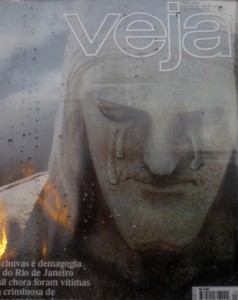
Photo © Michael Sommers.
Last week’s historic rainfall in Rio de Janeiro wreaked havoc upon the Cidade Maravilhosa. By the week’s end, the torrential rains had caused the deaths of 66 people in the capital (and over 250 people throughout the state), almost all of which were due to landslides that buried residents and their precariously-built homes. As usual, the victims were overwhelmingly poor.
The most shocking and tragic accident was the one that occurred in Rio’s twin sister of Niterói, located across Baía de Guanabara. On April 7, Morro da Bumba, a hillside that had served as a municipal garbage dump before growing into a favela, collapsed, burying over 200 residents (over 40 lost their lives) and leaving Niterói’s mayor, José Roberto Silveira, sheepishly acknowledging that his government, knowing the area was at risk, should have taken preventive steps against invasion of the morro.
Amidst the rescue and medical crews, authorities set up makeshift tents where relatives who had identified family members in the rubble could skip the usual bureaucracy and get a quick death certificate for their loved ones. The sad irony of how efficient the public sector was after the fact was not lost on the tens of millions of Brazilians who accompanied the tragedy on the nightly news.
Apart from the human toll, landslides and flooding left other damage in their wake. One of the greatest non-human casualties was the very symbol of Rio itself – the statue of Cristo Redentor… Apart from the human toll, landslides and flooding left other damage in their wake. One of the greatest non-human casualties was the very symbol of Rio itself – the statue of Cristo Redentor (Christ the Redeemer) which, from its privileged perch atop the Morro de Corcovado, appears like a beacon throughout the city. Although the 30-meter (100-foot) high Art Deco statue remains unscathed, due to mudslides in the surrounding Parque Nacional da Tijuca, access to Rio’s Number One tourist attraction is impossible. The trees, rocks, and dirt obstructing the roads and tramway line that lead to up to Corcovado are expected to be cleared within the next week or so. However, according to reports released early this week, it could be several months before the site is deemed safe enough for visitors.In order to speed things up, Rio’s municipal government pledged R$5 million (US$2.8 million) to facilitate work throughout the entire Parque Nacional da Tijuca, a swathe of dense Atlantic forest that constitutes the largest urban park in Brazil. City Hall has a major interest in having tourists return to Corcovado – the estimated loss of revenue could add up to over R$2.5 million (US$1.4 million) a month.
All in all, there were 283 landslides in the park, 50 of which were considered serious. Aside from Corcovado, other tourist sites that have been temporarily closed are the Museu do Açude (scheduled to reopen in June) and the far-flung Museu Casa do Pontal (expected to reopen in May).
Those who are planning a trip to Rio in the near (and dryer) future should take comfort in the fact that one thing Rio has a superabundance of is stunning panoramic views. Try Forte Duque de Caxias (atop Pedra do Leme), Mirante Leblon (at the end of Leblon beach), and the various lookouts inside the Parque do Penhasco Dois Irmãos. Of course, last, and definitely not least, there’s always Pão de Açúcar (Sugarloaf).